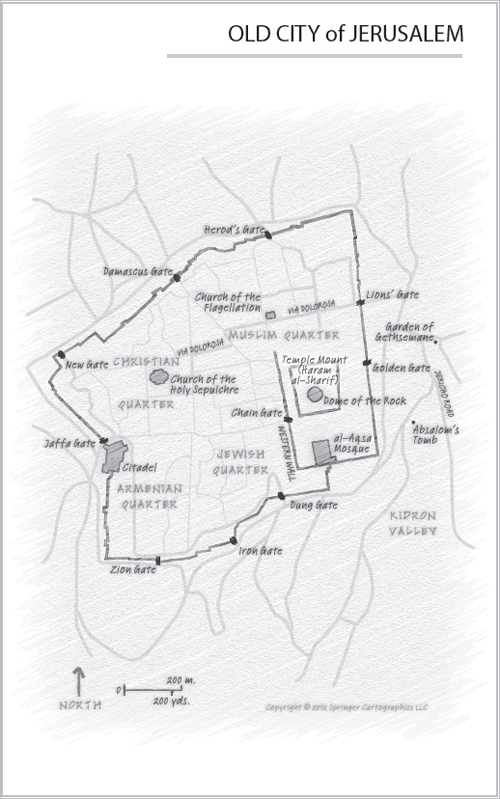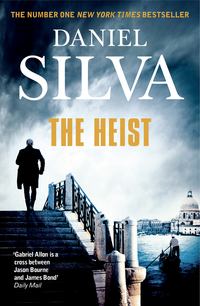
Полная версия
The Fallen Angel

DANIEL SILVA
The Fallen Angel

For Louis Toscano, who has been
there from the beginning. And,
as always, for my wife, Jamie, and
for my children, Lily and Nicholas.
I warn you against shedding blood,
indulging in it and making a habit of it,
for blood never sleeps.
SALADIN


Table of Contents
Title Page
Dedication
Epigraph
Maps
Part One: City of the Dead
1. Vatican City
2. Piazza di Spagna, Rome
3. The Sistine Chapel
4. St. Peter’s Basilica
5. Piazza di Spagna, Rome
6. Trastevere, Rome
7. Vatican City
8. Piazza di Spagna, Rome
9. Cerveteri, Italy
10. Piazza di Sant’Ignazio, Rome
11. Piazza di Sant’Ignazio, Rome
12. Villa Giulia, Rome
13. Apostolic Palace, Vatican City
14. The Vatican Gardens
15. Piazza di Spagna, Rome
16. The Via Veneto, Rome
Part Two: City of God
17. Ben Gurion Airport, Israel
18. Jerusalem
19. King Saul Boulevard, Tel Aviv
20. King Saul Boulevard, Tel Aviv
21. Rue de Miromesnil, Paris
22. Quai des Célestins, Paris
23. St. Moritz, Switzerland
24. St. Moritz, Switzerland
25. St. Moritz, Switzerland
26. Bern, Switzerland
27. Herndon, Virginia
28. Wannsee, Berlin
29. Berlin
30. Berlin
Part Three: The Well of Souls
31. Berlin–Northern Denmark
32. Kandestederne, Denmark
33. Vienna
34. Vienna
35. Vienna
36. Vienna–Tel Aviv–Vatican City
37. East Jerusalem
38. Vatican City
39. Vatican City–Jerusalem
40. Jerusalem
41. The Old City, Jerusalem
42. Tel Aviv–Jerusalem
43. The Old City, Jerusalem
44. Jerusalem
45. Jerusalem
46. The Temple Mount, Jerusalem
Part Four: Ego te Absolvo
47. Jerusalem
48. Jerusalem
49. Piazza di Sant’Ignazio, Rome
50. Vatican City
Author’s Note
Acknowledgments
About the Author
Also written by Daniel Silva
Copyright
About the Publisher
1
VATICAN CITY
IT WAS NICCOLÒ MORETTI, CARETAKER of St. Peter’s Basilica, who made the discovery that started it all. The time was 6:24 a.m., but owing to a wholly innocent error of transcription, the Vatican’s first official statement incorrectly reported it as 6:42. It was one of numerous missteps, large and small, that would lead many to conclude the Holy See had something to hide, which was indeed the case. The Roman Catholic Church, said a noteworthy dissident, was but one scandal away from oblivion. The last thing His Holiness needed now was a dead body in the sacred heart of Christendom.
A scandal was the last thing Niccolò Moretti had been expecting to find that morning when he arrived at the Vatican one hour earlier than his usual time. Dressed in dark trousers and a knee-length gray coat, he was scarcely visible as he hurried across the darkened piazza toward the steps of the Basilica. Glancing to his right, he saw lights burning in the third-floor windows of the Apostolic Palace. His Holiness Pope Paul VII was already awake. Moretti wondered whether the Holy Father had slept at all. The Vatican was swirling with rumors he was suffering from a crippling bout of insomnia, that he spent most nights writing in his private study or walking alone in the gardens. The caretaker had seen it before. Eventually, they all lost the ability to sleep.
Moretti heard voices behind him and, turning, saw a pair of Curial priests materialize from the gloom. They were engaged in animated conversation and paid him no heed as they marched toward the Bronze Doors and melted once more into the shadows. The children of Rome called them bagarozzi—black beetles. Moretti had used the word once as a child and had been scolded by none other than Pope Pius XII. He’d never said it since. When one is chastised by the Vicar of Christ, he thought now, one rarely repeats the same offense.
He hiked up the steps of the Basilica and slipped into the portico. Five doors led into the nave. All were sealed except for the one at the far left, the Door of Death. In the opening stood Father Jacobo, an emaciated-looking Mexican cleric with strawlike gray hair. He stepped aside so Moretti could enter, then closed the door and lowered the heavy bar. “I’ll come back at seven to let in your men,” the priest said. “Be careful up there, Niccolò. You’re not as young as you used to be.”
The priest withdrew. Moretti dipped his fingers in holy water and made the sign of the cross before setting out up the center of the vast nave. Where others might have paused to gaze in awe, Moretti forged on with the familiarity of a man entering his own home. As chief of the sampietrini, the official caretakers of the Basilica, he had been coming to St. Peter’s six mornings a week for the past twenty-seven years. It was because of Moretti and his men that the Basilica glowed with heaven’s light while the other great churches of Europe seemed forever shrouded in darkness. Moretti considered himself not only a servant of the papacy but a partner in the enterprise. The popes were entrusted with the care of one billion Roman Catholic souls, but it was Niccolò Moretti who looked after the mighty Basilica that symbolized their earthly power. He knew every square inch of the building, from the peak of Michelangelo’s dome to the depths of the crypt—all forty-four altars, twenty-seven chapels, eight hundred columns, four hundred statues, and three hundred windows. He knew where it was cracked and where it leaked. He knew when it was feeling well and when it was in pain. The Basilica, when it spoke, whispered into the ear of Niccolò Moretti.
St. Peter’s had a way of shrinking mere mortals, and Moretti, as he made his way toward the Papal Altar in the gray coat of his uniform, looked remarkably like a thimble come to life. He genuflected before the Confessio and then tilted his face skyward. Soaring nearly one hundred feet above him was the baldacchino, four twisting columns of bronze and gold crowned by a majestic canopy. On that morning, it was partially concealed by an aluminum scaffolding. Bernini’s masterpiece, with its ornate figures and sprigs of olive and bay, was a magnet for dust and smoke. Every year, in the week preceding the beginning of Lent, Moretti and his men gave it a thorough cleaning. The Vatican was a place of timeless ritual, and there was ritual, too, in the cleaning of the baldacchino. Laid down by Moretti himself, it stated that once the scaffolding was in place, he was always the first to scale it. The view from the summit was one that only a handful of people had ever seen—and Niccolò Moretti, as chief of the sampietrini, demanded the privilege of beholding it first.
Moretti climbed to the pinnacle of the front column, then, after attaching his safety line, inched his way on all fours up the slope of the canopy. At the very apex of the baldacchino was a globe supported by four ribs and crowned by a cross. Here was the most sacred spot in the Roman Catholic Church, the vertical axis running from the exact center of the dome straight down into the Tomb of St. Peter. It represented the very idea on which the enterprise rested. You are Peter and upon this rock I will build my church. As the first crepuscular rays of light illuminated the interior of the Basilica, Moretti, faithful servant of the popes, could almost feel the finger of God tapping him on the shoulder.
As usual, time slipped from his grasp. Later, when questioned by the Vatican police, he would be unable to recall exactly how long he had been atop the baldacchino before he saw the object for the first time. From Moretti’s lofty perspective, it appeared to be a broken-winged bird. He assumed it to be something innocent, a tarpaulin left by another sampietrino or perhaps a scarf dropped by a tourist. They were always leaving their possessions behind, Moretti thought, including things that had no business being in a church.
Regardless, it had to be investigated, and so Moretti, the spell broken, maneuvered himself cautiously around and made the long descent to the floor. He set out across the transept but within a few paces realized the object was not a discarded scarf or tarpaulin at all. Moving closer, he could see the blood dried on the sacred marble of his Basilica and the eyes staring upward into the dome, sightlessly, like his four hundred statues. “Dear God in heaven,” he whispered as he hurried down the nave. “Please take pity on her poor soul.”

The public would know little of the events immediately following Niccolò Moretti’s discovery, for they were carried out in the strictest tradition of the Vatican, in complete secrecy and with a hint of Jesuitical low cunning. No one beyond the walls would know, for example, that the first person Moretti sought out was the cardinal rector of the Basilica, an exacting German from Cologne with a well-honed instinct for self-preservation. The cardinal had been around long enough to recognize trouble when he saw it, which explained why he neglected to report the incident to the police, choosing instead to summon the true keeper of the law inside the Vatican.
Consequently, five minutes later, Niccolò Moretti would bear witness to an extraordinary scene—the private secretary to His Holiness Pope Paul VII picking through the pockets of a dead woman on the floor of the Basilica. The monsignor removed a single item and then set out for the Apostolic Palace. By the time he reached his office, he had settled on a course of action. There would have to be two investigations, he concluded, one for public consumption, the other for his own. And for the private inquiry to be successful, it would have to be carried out by a person of trust and discretion. Not surprisingly, the monsignor chose as his inquisitor a man much like himself. A fallen angel in black. A sinner in the city of saints.
2
PIAZZA DI SPAGNA, ROME
THE RESTORER DRESSED IN DARKNESS, silently, so as not to wake the woman. Posed as she was now, with her tousled chestnut hair and wide mouth, she reminded him of Modigliani’s Red Nude. He placed a loaded Beretta pistol next to her on the bed. Then he tugged at the duvet, exposing her heavy, rounded breasts, and the masterpiece was complete.
Somewhere a church bell tolled. A hand rose from the bedding, warm and lined from sleep, and drew the restorer down. The woman kissed him, as always, with her eyes closed. Her hair smelled of vanilla. On her lips was the faintest trace of the wine she had drunk the previous evening in a restaurant on the Aventine Hill.
The woman released him, murmured something unintelligible, and drifted back to sleep. The restorer covered her. Then he wedged a second Beretta into the waistband of his faded blue jeans and slipped out of the apartment. Downstairs, the pavements of the Via Gregoriana shimmered in the half-light like a newly varnished painting. The restorer stood in the doorway of the building for a moment while pretending to consult his mobile phone. It took him only a few seconds to spot the man watching him from behind the wheel of a parked Lancia sedan. He gave the man a friendly wave, the ultimate professional insult, and set off toward the Church of the Trinità dei Monti.
At the top of the Spanish Steps, an old gattara was dropping scraps of food into the sea of skinny Roman cats swirling at her feet. Dressed in a shabby overcoat and headscarf, she eyed the restorer warily as he headed down to the piazza. He was below average in height—five foot eight, perhaps, but no more—and had the spare physique of a cyclist. The face was long and narrow at the chin, with wide cheekbones and a slender nose that looked as though it had been carved from wood. The eyes were an unnatural shade of green; the hair was dark and shot with gray at the temples. It was a face of many possible origins, and the restorer possessed the linguistic gifts to put it to good use. Over the course of a long career, he had worked in Italy and elsewhere under numerous pseudonyms and nationalities. The Italian security services, aware of his past exploits, had tried to prevent his entry into the country but had relented after the quiet intervention of the Holy See. For reasons never made public, the restorer had been present at the Vatican several years earlier when it was attacked by Islamic terrorists. More than seven hundred people were killed that day, including four cardinals and eight Curial bishops. The Holy Father himself had been slightly wounded. He might very well have been among the dead had the restorer not shielded him from a shoulder-fired missile and then carried him to safety.
The Italians had imposed two conditions upon the restorer’s return—that he reside in the country under his real name and that he tolerate the presence of occasional physical surveillance. The first he accepted with a certain relief, for after a lifetime on the secret battlefield he was anxious to shed his many aliases and to assume something of a normal life. The second condition, however, had proved more burdensome. The task of following him invariably fell to young trainees. Initially, the restorer had taken mild professional offense until he realized he was being used as the subject of a daily master class in the techniques of street surveillance. He obliged his students by evading them from time to time, always keeping a few of his better moves in reserve lest he find himself in circumstances that required slipping the Italian net.
And so it was that as he made his way through the quiet streets of Rome, he was trailed by no fewer than three probationers of varying skills from the Italian security service. His route presented them with few challenges and no surprises. It bore him westward across the ancient center of the city and terminated, as usual, at St. Anne’s Gate, the business entrance of the Vatican. Because it was technically an international frontier, the watchers had no choice but to entrust the restorer to the care of the Swiss Guard, who admitted him with only a cursory glance at his credentials.
The restorer bade the watchers farewell with a doff of his flat cap and then set out along the Via Belvedere, past the butter-colored Church of St. Anne, the Vatican printing offices, and the headquarters of the Vatican Bank. At the Central Post Office, he turned to the right and crossed a series of courtyards until he came to an unmarked door. Beyond it was a tiny foyer, where a Vatican gendarme sat in a glass box.
“Where’s the usual duty officer?” the restorer asked in rapid Italian.
“Lazio played Milan last night,” the gendarme said with an apathetic shrug.
He ran the restorer’s ID badge through the magnetic card swipe and motioned for him to pass through the metal detector. When the machine emitted a shrill pinging, the restorer stopped in his tracks and nodded wearily at the gendarme’s computer. On the screen, next to the restorer’s unsmiling photograph, was a special notice written by the chief of the Vatican Security Office. The gendarme read it twice to make certain he understood it correctly, then, looking up, found himself staring directly into the restorer’s unusually green eyes. Something about the calmness of his expression—and the hint of a mischievous smile—caused the officer to give an involuntary shiver. He nodded toward the next set of doors and watched intently as the restorer passed through them without a sound.
So, the gendarme thought, the rumors were true. Gabriel Allon, renowned restorer of Old Master paintings, retired Israeli spy and assassin, and savior of the Holy Father, had returned to the Vatican. With a single keystroke, the officer cleared the file from the screen. Then he made the sign of the cross and for the first time in many years recited the act of contrition. It was an odd choice, he thought, because he was guilty of no sin other than curiosity. But surely that was to be forgiven. After all, it wasn’t every day a lowly Vatican policeman had the chance to gaze into the face of a legend.

Fluorescent lights, dimmed to their night settings, hummed softly as Gabriel entered the main conservation lab of the Vatican Picture Gallery. As usual, he was the first to arrive. He closed the door and waited for the reassuring thud of the automatic locks, then made his way along a row of storage cabinets toward the floor-to-ceiling black curtains at the far end of the room. A small sign warned the area beyond the curtains was strictly off-limits. After slipping through the breach, Gabriel went immediately to his trolley and carefully examined the disposition of his supplies. His containers of pigment and medium were precisely as he had left them. So were his Winsor & Newton Series 7 sable brushes, including the one with a telltale spot of azure near the tip that he always left at a precise thirty-degree angle relative to the others. It suggested the cleaning staff had once again resisted the temptation to enter his workspace. He doubted whether his colleagues had shown similar restraint. In fact, he had it on the highest authority that his tiny curtained enclave had displaced the espresso machine in the break room as the most popular gathering spot for museum staff.
He removed his leather jacket and switched on a pair of standing halogen lamps. The Deposition of Christ, widely regarded as Caravaggio’s finest painting, glowed under the intense white light. Gabriel stood motionless before the towering canvas for several minutes, hand pressed to his chin, head tilted to one side, eyes fixed on the haunting image. Nicodemus, muscular and barefoot, stared directly back as he carefully lowered the pale, lifeless body of Christ toward the slab of funerary stone where it would be prepared for entombment. Next to Nicodemus was John the Evangelist, who, in his desperation to touch his beloved teacher one last time, had inadvertently opened the wound in the Savior’s side. Watching silently over them were the Madonna and the Magdalene, their heads bowed, while Mary of Cleophas raised her arms toward the heavens in lamentation. It was a work of both immense sorrow and tenderness, made more striking by Caravaggio’s revolutionary use of light. Even Gabriel, who had been toiling over the painting for weeks, always felt as though he were intruding on a heartbreaking moment of private anguish.
The painting had darkened with age, particularly along the left side of the canvas where the entrance of the tomb had once been clearly visible. There were some in the Italian art establishment—including Giacomo Benedetti, the famed Caravaggisto from the Istituto Centrale per il Restauro—who wondered whether the tomb should be returned to prominence. Benedetti had been forced to share his opinion with a reporter from La Repubblica because the restorer chosen for the project had, for inexplicable reasons, failed to seek his advice before commencing work. What’s more, Benedetti found it disheartening that the museum had refused to make public the restorer’s identity. For many days, the papers had bristled with familiar calls for the Vatican to lift the veil of silence. How was it possible, they fumed, that a national treasure like The Deposition could be entrusted to a man with no name? The tempest, such as it was, finally ended when Antonio Calvesi, the Vatican’s chief conservator, acknowledged that the man in question had impeccable credentials, including two masterful restorations for the Holy See—Reni’s Crucifixion of St. Peter and Poussin’s Martyrdom of St. Erasmus. Calvesi neglected to mention that both projects, conducted at a remote Umbrian villa, had been delayed due to operations the restorer had carried out for the secret intelligence service of the State of Israel.
Gabriel had hoped to restore the Caravaggio in seclusion as well, but Calvesi’s decree that the painting never leave the Vatican had left him with no choice but to work inside the lab, surrounded by the permanent staff. He was the subject of intense curiosity, but then, that was to be expected. For many years, they had believed him to be an unusually gifted if temperamental restorer named Mario Delvecchio, only to learn that he was something quite different. But if they felt betrayed, they gave no sign of it. Indeed, for the most part, they treated him with a tenderness that came naturally to those who care for damaged objects. They were quiet in his presence, mindful to a point of his obvious need for privacy, and were careful not to look too long into his eyes, as if they feared what they might find there. On those rare occasions when they addressed him, their remarks were limited mainly to pleasantries and art. And when office banter turned to the politics of the Middle East, they respectfully muted their criticism of the country of his birth. Only Enrico Bacci, who had lobbied intensely for the Caravaggio restoration, objected to Gabriel’s presence on moral grounds. He referred to the black curtain as “the Separation Fence” and adhered a “Free Palestine” poster to the wall of his tiny office.
Gabriel poured a tiny pool of Mowolith 20 medium onto his palette, added a few granules of dry pigment, and thinned the mixture with Arcosolve until it reached the desired consistency and intensity. Then he slipped on a magnifying visor and focused his gaze on the right hand of Christ. It hung in the manner of Michelangelo’s Pietà, with the fingers pointing allegorically toward the corner of the funerary stone. For several days, Gabriel had been attempting to repair a series of abrasions along the knuckles. He was not the first artist to struggle over the composition; Caravaggio himself had painted five other versions before finally completing the painting in 1604. Unlike his previous commission—a depiction of the Virgin’s death so controversial it was eventually removed from the church of Santa Maria della Scala—The Deposition was instantly hailed as a masterwork, and its reputation quickly spread throughout Europe. In 1797, the painting caught the eye of Napoléon Bonaparte, one of history’s greatest looters of art and antiquities, and it was carted over the Alps to Paris. It remained there until 1817, when it was returned to the custody of the papacy and hung in the Vatican.






